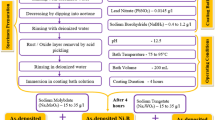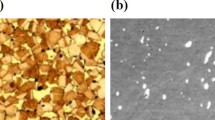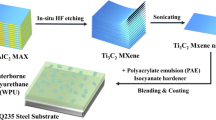Abstract
In this study, SiO2 nanoparticles were modified using triethoxyoctylsilane to fabricate a corrosion-resistant superhydrophobic coating on brass. The brass substrate of 1 × 1 cm2 was cut from the bulk using an electrical discharge machine (EDM) that generated a micro-pattern on its surface then it was chemically etched with Piranha solution. In order to create nano roughness on the etched micro-patterned brass substrate and to reduce its surface energy, surface-modified SiO2 nanoparticles were coated on the brass using the solution-immersion approach followed by annealing. AFM and FESEM analysis of the coated brass showed the presence of SiO2 nanoparticles and their clusters leading to the superhydrophobicity. The coated brass exhibited a maximum water contact angle (CA) of 152° ± 2° and a sliding angle (SA) of 7° ± 3°. The electrochemical impedance spectroscopy (EIS) plots demonstrated a high impedance value for coated brass compared to uncoated brass. Conversely, the corrosion current density (Icorr) of coated brass (0.068 × 10−6 A cm2) is much lower than the uncoated brass (0.369 × 10−6 A cm2) signifying efficient corrosion resistance of the coated brass. The present work has inordinate potential to control the corrosion of metals in corrosive conditions.
Graphical Abstract









Similar content being viewed by others
References
Zahner LW (2020) Copper, brass, and bronze surfaces: a guide to alloys, finishes, fabrication, and maintenance in architeture and art. Wiley, Kansas City, USA
Singh RK (2019) Study the corrosion and corrosion protection of brass sculpture by atmospheric pollutants in winter Season. Mod Approaches Mater Sci 1. https://doi.org/10.32474/mams.2019.01.000111
Dominic J, Perumal G, Grewal HS, Arora HS (2020) Facile fabrication of superhydrophobic brass surface for excellent corrosion resistance. Surf Eng 36:660–664. https://doi.org/10.1080/02670844.2020.1727687
Yu Z, Zhou C, Liu R et al. (2020) Fabrication of superhydrophobic surface with enhanced corrosion resistance on H62 brass substrate. Colloids Surf A Physicochem Eng Asp 589:124475. https://doi.org/10.1016/j.colsurfa.2020.124475
Mahadik SA, Pedraza F, Vhatkar RS (2016) Silica based superhydrophobic coating for long-term industrial and domestic applications. J Alloy Compd 663:487–493. https://doi.org/10.1016/j.jallcom.2015.12.016
Varshney P, Mohapatra SS (2018) Durable and regenerable superhydrophobic coatings for brass surfaces with excellent self-cleaning and anti-fogging properties prepared by immersion technique. Tribol Int 123:17–25. https://doi.org/10.1016/j.triboint.2018.02.036
Li X, Jiang Y, Jiang Z et al. (2021) Improvement of corrosion resistance of H59 brass through fabricating superhydrophobic surface using laser ablation and heating treatment. Corros Sci 180:109186. https://doi.org/10.1016/j.corsci.2020.109186
Hu Z, Ma F, Liu L et al. (2022) Fluorine-free superhydrophobic coating with mechanical interlocking and high corrosion resistance. Prog Org Coat 168:106871. https://doi.org/10.1016/j.porgcoat.2022.106871
Jia C, Zhu J, Zhang L (2022) An anti‐corrosion superhydrophobic copper surface fabricated by milling and chemical deposition. Coatings 12:442. https://doi.org/10.3390/coatings12040442
Hooda A, Goyat MS, Pandey JK et al. (2020) A review on fundamentals, constraints and fabrication techniques of superhydrophobic coatings. Prog Org Coat 142:105557
Hooda A, Goyat MS, Gupta R et al. (2017) Synthesis of nano-textured polystyrene/ZnO coatings with excellent transparency and superhydrophobicity. Mater Chem Phys 193:447–452. https://doi.org/10.1016/j.matchemphys.2017.03.011
Sharma V, Goyat MS, Hooda A et al. (2020) Recent progress in nano-oxides and CNTs based corrosion resistant superhydrophobic coatings: a critical review. Prog. Org Coat 140:105512
Hooda A, Goyat MS, Kumar A, Gupta R (2018) A facile approach to develop modified nano-silica embedded polystyrene based transparent superhydrophobic coating. Mater Lett 233:340–343. https://doi.org/10.1016/j.matlet.2018.09.043
Pehkonen SO, Yuan S (2018) Superhydrophobic Film Coatings for Corrosion Inhibition. Interface Sci Technol 23:133–184. https://doi.org/10.1016/B978-0-12-813584-6.00006-5
Wang J, Wang X, Zhao S et al. (2020) Robust superhydrophobic mesh coated by PANI/TiO2 nanoclusters for oil/water separation with high flux, self-cleaning, photodegradation and anti-corrosion. Sep Purif Technol 235:116166. https://doi.org/10.1016/j.seppur.2019.116166
Jadhav AJ, Holkar CR, Pinjari DV (2018) Anticorrosive performance of super-hydrophobic imidazole encapsulated hollow zinc phosphate nanoparticles on mild steel. Prog Org Coat 114:33–39. https://doi.org/10.1016/j.porgcoat.2017.09.017
Bormashenko E, Stein T, Whyman G et al. (2006) Wetting properties of the multiscaled nanostructured polymer and metallic superhydrophobic surfaces. Langmuir 22:9982–9985. https://doi.org/10.1021/la061622m
Mahato S, Gupta A, Justin J, et al. (2018) Development of polystyrene/SiO2 superhydrophobic coating on metal substrates for corrosion protection. In: International conference on nano for energy and water. pp 25–29. Springer, Dehradun, India
Lai Y, Tang Y, Gong J et al. (2012) Transparent superhydrophobic/superhydrophilic TiO2-based coatings for self-cleaning and anti-fogging. J Mater Chem 22:7420–7426. https://doi.org/10.1039/c2jm16298a
Lai Y, Tang Y, Gong J et al. (2012) Transparent superhydrophobic/superhydrophilic TiO2-based coatings for self-cleaning and anti-fogging. J Mater Chem 22:7420–7426. https://doi.org/10.1039/c2jm16298a
Varshney P, Mohapatra SS, Kumar A (2016) Superhydrophobic coatings for aluminium surfaces synthesized by chemical etching process. Int J Smart Nano Mater 7:248–264. https://doi.org/10.1080/19475411.2016.1272502
Wu Y, Zhou Z, Tuo Y et al. (2015) A transparent CNTs/TiO2 composite film with superhydrophobic and photocatalytic functions self-assembled by liquid-phase deposition. Mater Chem Phys 149:522–529. https://doi.org/10.1016/j.matchemphys.2014.11.002
Ebert D, Bhushan B (2012) Transparent, superhydrophobic, and wear-resistant coatings on glass and polymer substrates using SiO2, ZnO, and ITO nanoparticles. Langmuir 28:11391–11399. https://doi.org/10.1021/la301479c
Saji VS (2021) Carbon nanostructure-based superhydrophobic surfaces and coatings. Nanotechnol Rev 10:518–571
Dong Z, Vuckovac M, Cui W et al. (2021) 3D printing of superhydrophobic objects with bulk nanostructure. Adv Mater 33. https://doi.org/10.1002/adma.202106068
Dominic J, Perumal G, Grewal HS, Arora HS (2020) Facile fabrication of superhydrophobic brass surface for excellent corrosion resistance. Surf Eng 36:660–664. https://doi.org/10.1080/02670844.2020.1727687
Cao N, Miao Y, Zhang D et al. (2018) Preparation of mussel-inspired perfluorinated polydopamine film on brass substrates: Superhydrophobic and anti-corrosion application. Prog Org Coat 125:109–118. https://doi.org/10.1016/j.porgcoat.2018.09.007
Jie H, Xu Q, Wei L, Min YL (2016) Etching and heating treatment combined approach for superhydrophobic surface on brass substrates and the consequent corrosion resistance. Corros Sci 102:251–258. https://doi.org/10.1016/j.corsci.2015.10.013
Sharma K, Hooda A, Goyat MS et al. (2022) A review on challenges, recent progress and applications of silica nanoparticles based superhydrophobic coatings. Ceram Int 48:5922–5938
Li H, Chen X, Shen D et al. (2021) Functionalized silica nanoparticles: classification, synthetic approaches and recent advances in adsorption applications. Nanoscale 13:15998–16016
Gisbert-Garzarán M, Vallet-Regí M (2020) Influence of the surface functionalization on the fate and performance of mesoporous silica nanoparticles. Nanomaterials 10. https://doi.org/10.3390/nano10050916
Voncken JHL, Verkroost TW (1997) Powder diffraction of cubic oα-brass. Powder Diffr 12:228–229. https://doi.org/10.1017/s0885715600009787
Galai M, Benqlilou H, EbnTouhami M et al. (2021) Effect of phosphorus content of α-brass on its corrosion resistance in aggressive soil: experimental and characterization studies. Eur Mediterranean J Environ Integr 6:1–16. https://doi.org/10.1007/s41207-021-00244-9
Jie H, Xu Q, Wei L, Min YL (2016) Etching and heating treatment combined approach for superhydrophobic surface on brass substrates and the consequent corrosion resistance. Corros Sci 102:251–258. https://doi.org/10.1016/j.corsci.2015.10.013
Fan H, Li S, Zhao Z et al. (2011) Inhibition of brass corrosion in sodium chloride solutions by self-assembled silane films. Corros Sci 53:4273–4281. https://doi.org/10.1016/j.corsci.2011.08.039
Tan J, Hao J, An Z, Liu C (2017) Superhydrophobic surfaces on brass substrates fabricated: via micro-etching and a growth process. RSC Adv 7:26145–26152. https://doi.org/10.1039/c7ra03308g
Zhang YL, Xia H, Kim E, Sun HB (2012) Recent developments in superhydrophobic surfaces with unique structural and functional properties. Soft Matter 8:11217–11231. https://doi.org/10.1039/c2sm26517f
Wang Z, Zhu L, Li W et al. (2013) Superhydrophobic surfaces on brass with controllable water adhesion. Surf Coat Technol 235:290–296. https://doi.org/10.1016/j.surfcoat.2013.07.054
Miwa M, Nakajima A, Fujishima A et al. (2000) Effects of the surface roughness on sliding angles of water droplets on superhydrophobic surfaces. Langmuir 16:5754–5760. https://doi.org/10.1021/la991660o
Yu Z, Ji Z, Tao D et al. (2020) Research on a reversible superwetting behavior and its corrosion resistance. Appl Surf Sci 517:146145. https://doi.org/10.1016/j.apsusc.2020.146145
Liu C, Su F, Liang J, Huang P (2014) Facile fabrication of superhydrophobic cerium coating with micro-nano flower-like structure and excellent corrosion resistance. Surf Coat Technol 258:580–586. https://doi.org/10.1016/j.surfcoat.2014.08.032
Xue Y, Wang S, Zhao G et al. (2019) Fabrication of Ni–Co coating by electrochemical deposition with high super-hydrophobic properties for corrosion protection. Surf Coat Technol 363:352–361. https://doi.org/10.1016/j.surfcoat.2019.02.056
Li MM, Xu QJ, Han J et al. (2015) Inhibition action and adsorption behavior of green inhibitor Sodium carboxymethyl cellulose on copper. Int J Electrochem Sci 10:9028–9041
Author contributions
All authors contributed to the study conception and design. Material preparation, data collection and analysis were performed by KS, MKM, AC, SD, DSA and MSG. The first draft of the manuscript was written by KS and all authors commented on previous versions of the manuscript. All authors read and approved the final manuscript.
Funding
This work was supported by University of Petroleum and Energy Studies (UPES), Dehradun under SEED Grant No. UPES/R&D/09032020/28. Author MSG has received research support from UPES.
Author information
Authors and Affiliations
Corresponding author
Ethics declarations
Conflict of interest
The authors declare no competing interests.
Additional information
Publisher’s note Springer Nature remains neutral with regard to jurisdictional claims in published maps and institutional affiliations.
Rights and permissions
Springer Nature or its licensor (e.g. a society or other partner) holds exclusive rights to this article under a publishing agreement with the author(s) or other rightsholder(s); author self-archiving of the accepted manuscript version of this article is solely governed by the terms of such publishing agreement and applicable law.
About this article
Cite this article
Sharma, K., Malik, M.K., Chawla, A. et al. Development of corrosion-resistant superhydrophobic coating on brass using modified silica nanoparticles. J Sol-Gel Sci Technol 105, 701–708 (2023). https://doi.org/10.1007/s10971-022-06018-1
Received:
Accepted:
Published:
Issue Date:
DOI: https://doi.org/10.1007/s10971-022-06018-1




